Workouts for Week 1
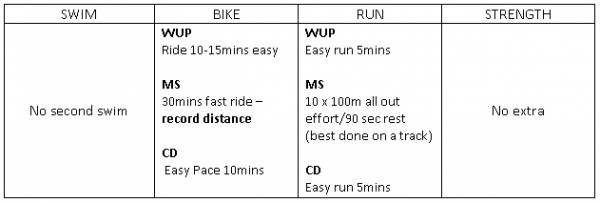
Survived week one and ready for more?
It’s normal to question your training at times. Am I doing enough training? Do I need to do more? Am I working hard enough?
Yes, you are doing enough, and adding more will not get you the results you need. You can do too much and over train, which results in injury and sickness. But more on the subject of overtraining in another week.
Questions about working hard enough are mostly answered during training. Are you gasping for breath? Are you cursing me? Are you fighting to finish the set? If yes, than you are working hard enough! The great part about working at hard or all out efforts is that as you become fitter you are still pushing at a hard effort just at your new level of fitness.
Science shows that doing long slow efforts in workouts will not make you fitter. That “LSD” effort of 70% will net you 70% fitness. Who wants that? That’s why I will have you repeat some workouts over and over. You will see the difference. But, if you like to read long, boring science studies:
Six sessions of sprint interval training increases muscle oxidative potential and cycle endurance capacity in humans.
Click on the number below that corresponds to the week of training you’re in.
Workouts for Week 2
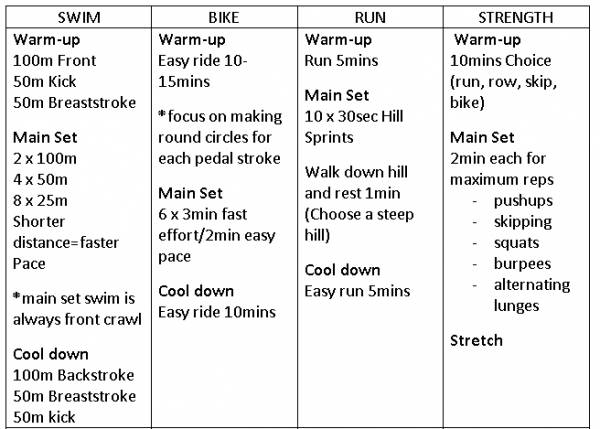
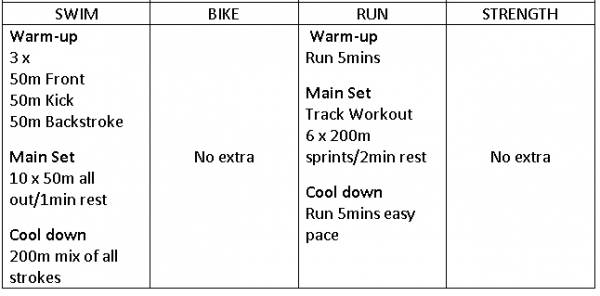
How-to: Fueling During Exercise
Just as what you eat before you exercise greatly affects your energy levels, so does what you eat during exercise. This is when you need to balance your sweat losses and energy output with enough water and carbohydrates to remain hydrated and maintain normal blood sugar levels for optimum performance.
You can increase your stamina by consuming 100-250 calories of carbs per hour during endurance exercise AFTER the first hour. This could be four eight-ounce sports drink, or a carbohydrate gel with lots of water to wash it down. Your body doesn’t care if you ingest solid or liquid carbohydrates, both are equally effective. You’ll learn which settle best in your body and how much is appropriate.
Keep in mind that too much sugar or food taken at once can reduce the rate at which fluids leave the stomach and become available to replace sweat loss. Be more conservative with carbohydrates during hot weather, when rapid fluid replacement is perhaps more important than carbohydrate replacement.
Race day is not the time to experiment with sports drinks and carbohydrate replacement. Experiment during training, in all types of conditions, well in advance of race day.
Click on the number below that corresponds to the week of training you’re in.
Workouts for Week 3
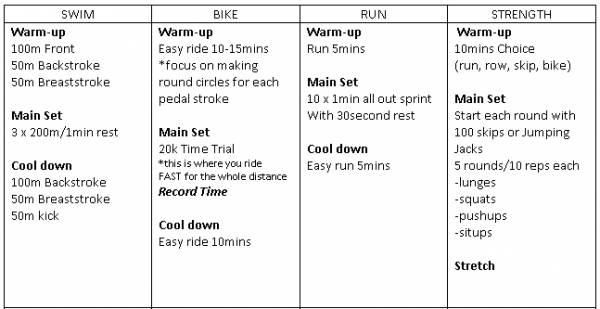
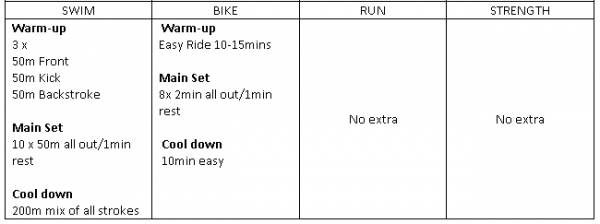
I’m so tired!
Feeling tired? Fatigue is a very common complaint and affects athletes of all ages, sizes and abilities.
Fatigue is a subjective condition in which a person feels tired before beginning an activity, lacks the energy to accomplish tasks requiring sustained effort and attention, and becomes unduly exhausted after normal activities.
It is important to remember that the human body requires 7-10 hours of sleep in each 24-hour period. When we don’t have enough time, the first place we typically cut back is sleep time. If you are getting up early to exercise, or staying up late, it is important to adjust your sleep time accordingly. If continuous sleep is not possible, a 20- to 40-minute nap during the day may help.
An overlooked cause of fatigue in the athletic adult is overtraining. One of the hardest things for an athlete to do is rest. The mindset is to push harder to get stronger and faster. We forget that it is possible to get too much of a good thing, even exercise, and that rest is an important part of training. We need to have a balance between training and recovery.
If an imbalance occurs and is allowed to persist, overtraining results. Athletes, and those around them, will notice lingering fatigue, mood changes, irritability, altered sleep and persistent soreness. Performance in workouts or competition may deteriorate. Frequent respiratory illnesses or even an overuse injury may occur.
The cure for overtraining is rest. The more severe the problem, the more rest needed to fix it. This can be very difficult to do until illness or injury forces the rest to occur. Prevention can help the adult athlete avoid this problem.
Rest can be the time when no strenuous activity is performed; such as in sleep time or days off. It can also be more active and involve low-intensity exercise, allowing a small amount of increased blood flow to reach the muscles. Both types of rest allow recovery to occur. Recovery is what the body does during rest periods to repair the damage to muscle cells after strenuous activity. If the body is given enough rest to allow adequate recovery, the body will completely repair the broken-down muscle cells and even build them up a little stronger, resulting in a stronger and faster athlete.
There are many causes of fatigue in the athletic adult. It is important to listen to your body and heed your body’s warning signs. It is also important to remember that unrelenting fatigue may be a sign of underlying illness, and you should consult with your physician if this occurs.
Click on the number below that corresponds to the week of training you’re in.
Workouts for Week 4
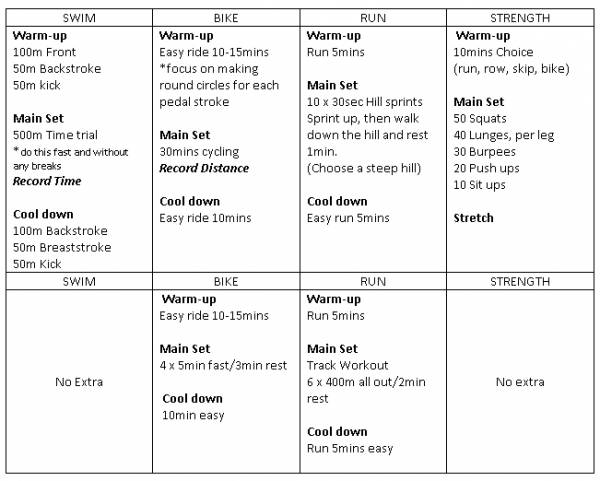
Keep Negativity out!
Thinking negatively causes failure. Thinking positively causes success. The power of positive words and thoughts can improve our experience in a race situation by increasing our self-confidence as an athlete.
Experiment with positive self-talk during training and then apply it to racing. For example, if you don’t enjoy hills, wind or swimming, try repeating over and over that you “love” hills, wind and swimming. You will notice a difference in your strength and energy. The result is a more natural and powerful performance.
Triathlon races, especially at the ironman distance, can be an emotional roller coaster. It’s a long day with highs and lows and it’s a real challenge to keep negative thoughts away. Negativity can ruin your race and possibly make it impossible to finish. One must be strong-minded to turn these nasty demons into angels, otherwise you may find a fist of fury coming down on you.
We all experience nervousness before big events. It’s a perfectly natural feeling. This is the time to be strong, avoid self-doubt, have confidence in yourself, and know you are prepared. It’s important when you get to the start line to remember – your body did the work! Racing is the reward for all the hard training.
Click on the number below that corresponds to the week of training you’re in.
Workouts for Week 5
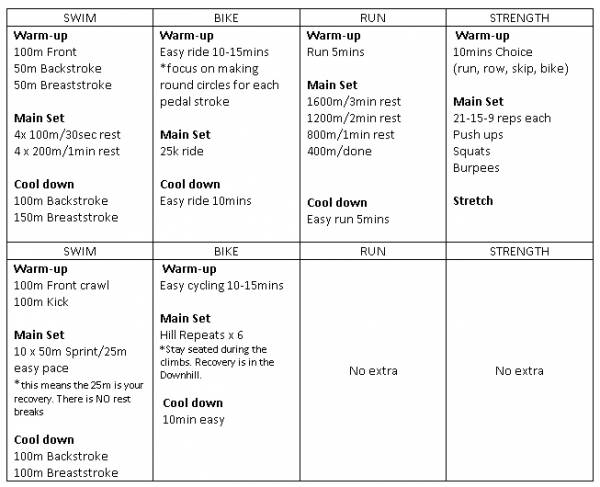
Click on the number below that corresponds to the week of training you’re in.
Workouts for Week 6
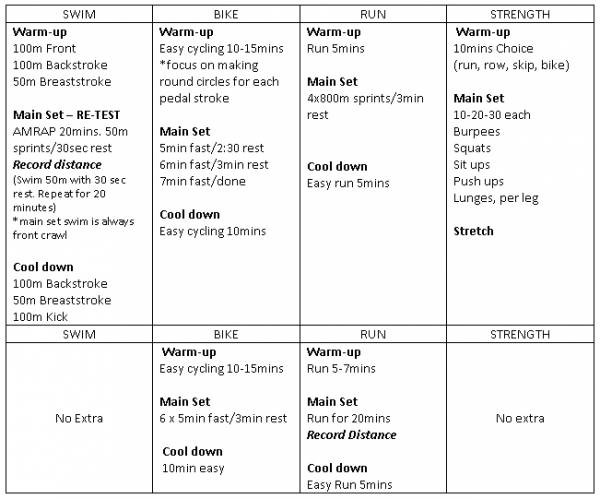
Are you ready to race?
As we pass the halfway mark of the first block of training, you need to decide if you should do a triathlon at the end of the first twelve weeks. It could be a “Try a Tri” (mini sprint) or a sprint-distance race. If you have been doing the training, you will be ready.
Try a Tri (mini sprint): Swim 350-400m, Bike 10-15k, Run 2-3k
Sprint: Swim 750m, Bike 20-25k, Run 5k
Every race is different, and distances can vary. Search for races in your area to see if there are any running at the end of the twelve weeks and what distances they are. Go watch a local race to get an idea of what it will be like to be racing. This can also help with race day anxiety.
Click on the number below that corresponds to the week of training you’re in.
Workouts for Week 7
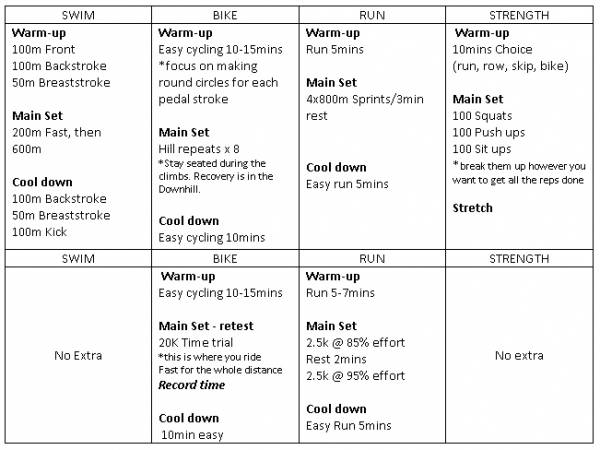
Brick Workouts
Oh, the dreaded brick workout. The combination of biking and running will leave you literally weak in the knees. Bricks are an important part of your training that enhances aerobic endurance, race pacing, and transition skill. They also help in determining what race attire to wear, since you need to be able to swim, bike, and run in the same outfit.
To be successful, you will need to have your running shoes, water, sunglasses and hat (optional) ready for the end of the bike. Move quickly to transition from bike to run, and then get running. The first 100-200m will not be enjoyable, but keep at it. The better you get, the easier it will be.
We will ease into the brick workouts now to prepare you if you wish to do a race in a couple weeks. In the next two twelve-week programming blocks we will leave them out due to the inclement weather in most of the country and lack of racing available.
Click on the number below that corresponds to the week of training you’re in.
Workouts for Week 8
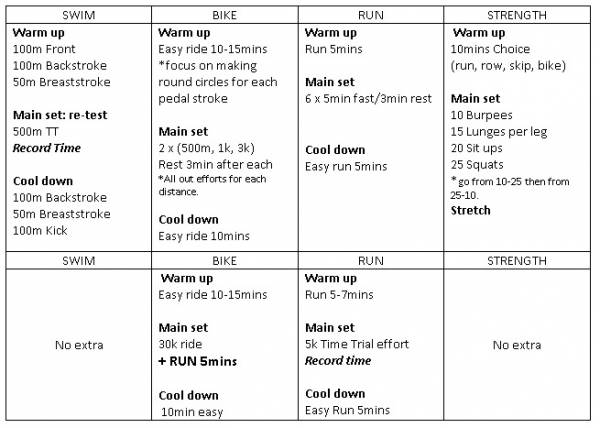
Click on the number below that corresponds to the week of training you’re in.
Workouts for Week 9
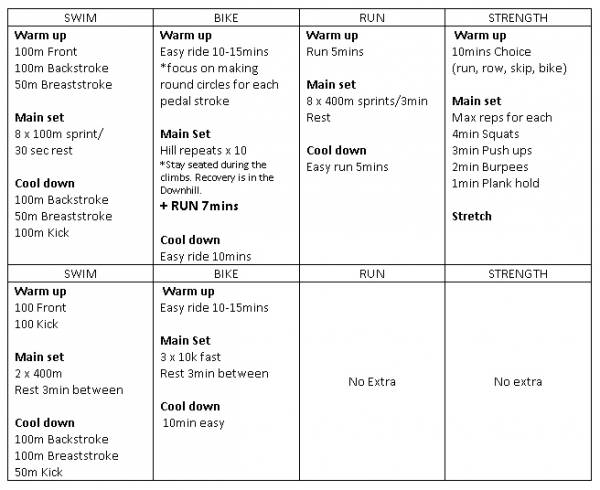
Pre-race Checklist Coming Next Week
Next week will include a pre-race check list so you can make sure you will have all the supplies you need to start and finish a triathlon.
Feel free to add what you may need. Every time you do a race you will learn something new. It may be about you or how to prepare better for what could happen.
Click on the number below that corresponds to the week of training you’re in.
Workouts for Week 10
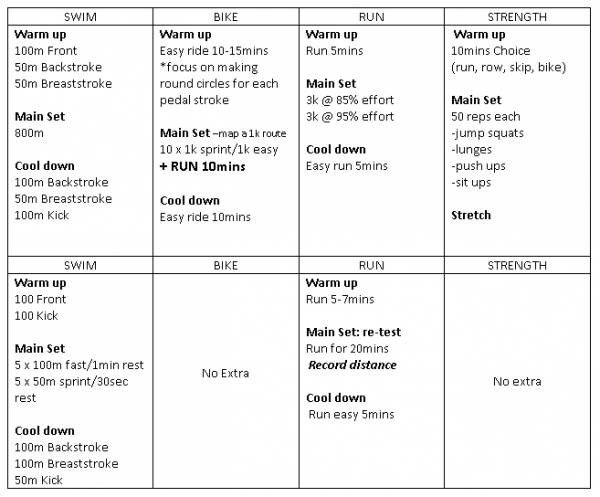
Transitions
A triathlon requires that we transition quickly from one sport to another. This is considered the fourth event, a skill that you must train. It can be a real time saver if you do it well. The time clock does not stop so you can tie your shoelaces. There is no chance to change clothes so you must swim/bike/run in the same outfit.
Race day is not the time to try a new outfit or shoes. Everything must be used in training to determine if it fits well, is comfortable and performs the way you need it to. Practice at least once a week to get the hang of it. Here is a super easy to follow video to get an idea.
The Equipment List, As Promised
Swim:
- Swim Suit/Tri Suit
- Goggles
- Wetsuit
- Swim Cap (always have an extra, just in case)
- Towel(s)
- Body Glide
- Flip Flops
Bike:
- Bike (Seriously!)
- Helmet
- Cycling Shoes/Socks
- Water Bottles
- Spare Tubes/Tires/Patch Kit
- Sunglasses
- Floor Pump
- Tools
Run:
- Hat
- Running Shoes/Socks
- Nutrition:
- Water
- Energy Bar
- Gels
- Sport Drink
General:
- Watch
- Heart Rate Monitor (if using one)
- Sunscreen
- Race Belt
- Safety Pins
- Race information/maps
- Money/ID
- Extra clothes for after the race
- Duct tape (you never know!)
Click on the number below that corresponds to the week of training you’re in.
Workouts for Week 11
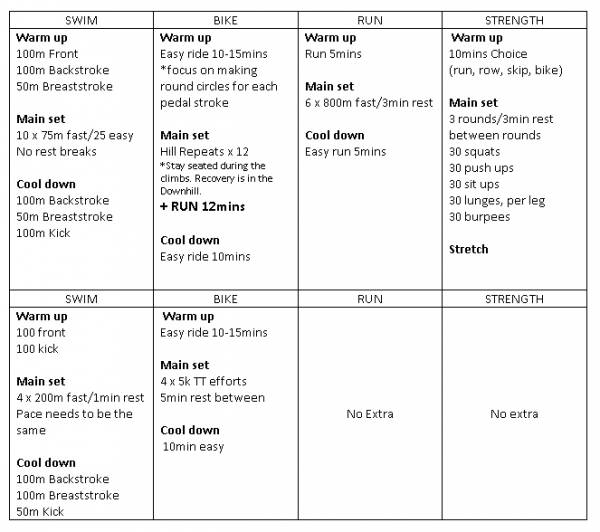
Click on the number below that corresponds to the week of training you’re in.
Workouts for Week 12
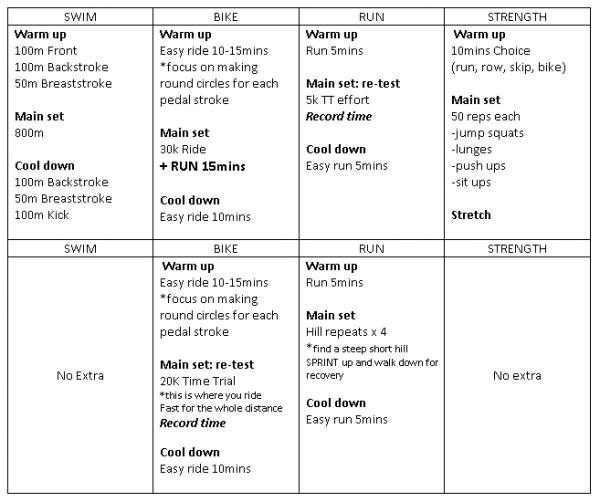
You made it!
Congratulations! As you finish 12 weeks, you should be feeling fitter and faster. Maybe it’s time to test your training?
Try creating your own race at your local pool or lake. Include family and/or friends to join or support you. As we progress towards more training we will cover more information to help you conquer any race. Now, look forward to joining me for another twelve weeks and finding a goal race to work towards!
Click on the number below that corresponds to the week of training you’re in.






